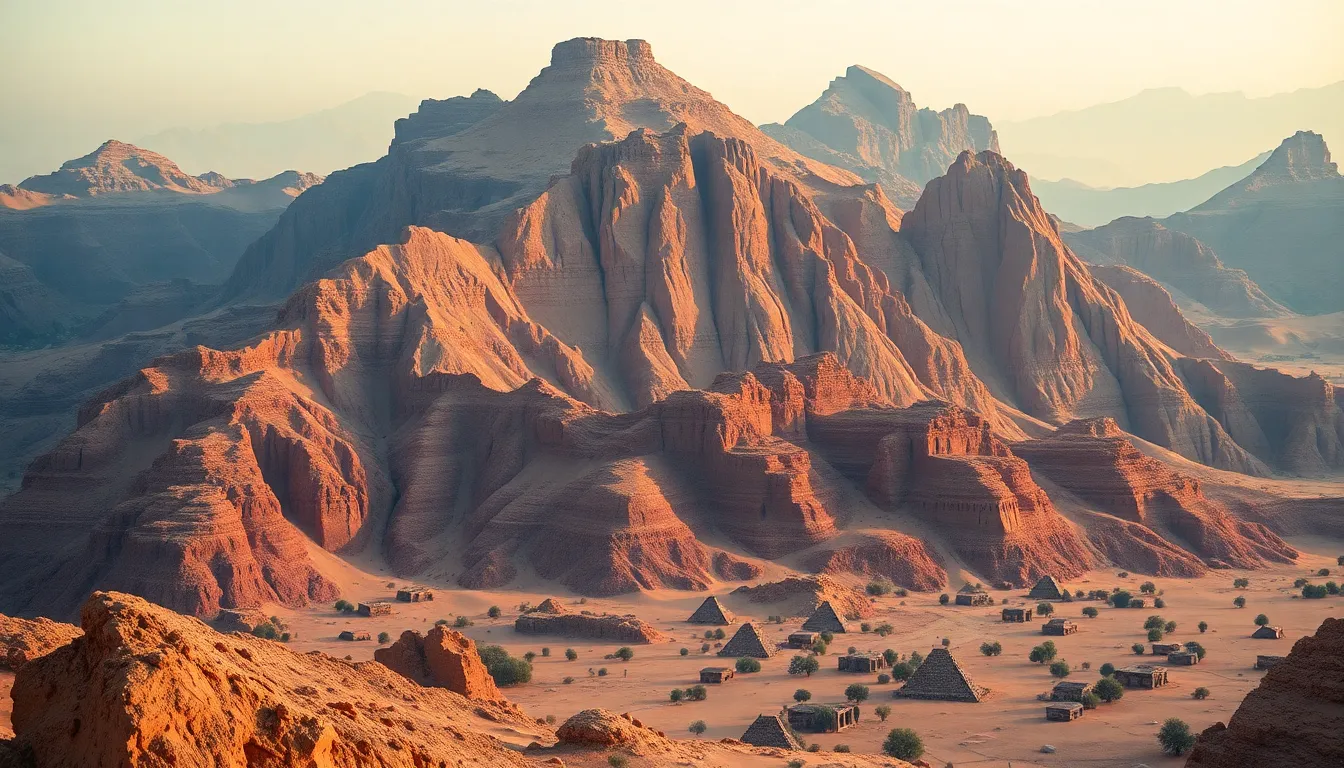The Sacred Mountains of Ancient Egypt: A Spiritual Landscape
I. Introduction
Ancient Egypt, known for its rich history and complex spirituality, was deeply intertwined with its geography. The vast deserts, fertile banks of the Nile, and majestic mountains shaped not only the physical landscape but also the spiritual beliefs of its people. Among these geographical features, sacred mountains held a prominent place in Egyptian culture, serving as symbols of divine connection and places of worship.
This article explores the significance of sacred mountains in Ancient Egypt, their role in spirituality, the major mountains revered by the Egyptians, and the impact of these sacred sites on their religious practices and artistic expressions.
II. The Role of Geography in Egyptian Spirituality
The natural landscapes of Egypt were not merely backdrops but integral components of its spiritual framework. The Egyptians saw their environment as imbued with divine presence, where each element held meaning and significance.
- The significance of natural landscapes: The Nile River, deserts, and mountains were all viewed as manifestations of the gods’ power.
- Mountains as symbols of divine connection: Elevated terrains were considered closer to the heavens, making them sacred sites for worship and offerings.
- Influence of geography on religious practices: Rituals and religious observances were often tied to specific geographical features, reinforcing the connection between the land and the divine.
III. Major Sacred Mountains in Ancient Egypt
Several mountains in Ancient Egypt were particularly revered, each with its own historical significance and spiritual practices.
A. Jebel Barkal: The Mountain of the Gods
Jebel Barkal, located in modern-day Sudan, was considered the ‘Mountain of the Gods’ by the Egyptians. This mountain was not only a geographical landmark but also a significant religious site.
- Historical significance: Jebel Barkal was associated with the god Amun and was believed to be the place where the divine manifested on earth.
- Religious practices associated with Jebel Barkal: Pilgrimages were made to this mountain, where rituals included offerings and prayers to Amun, seeking blessings and guidance.
B. Mount Sinai: Spiritual Pilgrimages
Although primarily known for its biblical significance, Mount Sinai also held a place in Ancient Egyptian beliefs.
- Connections to Abrahamic faiths: Mount Sinai is a site of great importance to Judaism, Christianity, and Islam, marking it as a focal point of spiritual pilgrimage.
- Significance in Ancient Egyptian beliefs: The mountain was seen as a place where the gods descended, and it was often associated with divine revelation and law.
C. The Eastern and Western Deserts: Sacred Peaks
The Eastern and Western Deserts of Egypt also contained sacred peaks that were integral to various religious practices. These mountains served as retreats for spiritual contemplation and as venues for rites.
IV. Mythology and Cosmology of the Mountains
Mountains played a significant role in Egyptian mythology and cosmology, often associated with creation myths and the abode of deities.
- Creation myths involving mountains: Some myths describe mountains as the first land to emerge from the primordial waters, symbolizing creation and stability.
- Mountains as abodes of gods and goddesses: Many deities were believed to reside in or on mountains, making these places sacred and worthy of worship.
- Symbolism of mountains in Egyptian mythology: Mountains represented strength, permanence, and the connection between the earth and the heavens.
V. Pilgrimages and Rituals Associated with Sacred Mountains
Pilgrimages to sacred mountains were common in Ancient Egypt and were seen as acts of devotion.
- Historical accounts of pilgrimages: Records indicate that many Egyptians traveled to sacred sites to seek divine favor and engage in communal worship.
- Rituals performed at sacred sites: Rituals ranged from offerings and prayers to elaborate ceremonies designed to honor the gods and seek their blessings.
- The impact of these practices on community life: These pilgrimages fostered a sense of community and shared belief, reinforcing social bonds and cultural identity.
VI. Artistic Representations of Sacred Mountains
The significance of sacred mountains extended into art and literature, where they were frequently depicted and celebrated.
- Depictions in hieroglyphics and tomb paintings: Mountains were often illustrated in tombs, symbolizing the journey to the afterlife and the connection to the divine.
- Literature and poetry celebrating mountains: Ancient texts often extolled the virtues of mountains as places of divine communication and spiritual refuge.
- Influence on later art and culture: The reverence for sacred mountains influenced subsequent artistic expressions throughout history, reflecting the enduring legacy of these spiritual landscapes.
VII. The Decline of Sacred Mountain Worship
Over time, the worship of sacred mountains faced challenges and decline.
- Factors contributing to the decline: Changes in political power, cultural shifts, and the rise of new religious ideologies impacted traditional practices.
- The transition to monotheism and its impact: The advent of monotheistic beliefs led to the marginalization of polytheistic practices, including mountain worship.
- Modern interpretations and reverence for ancient practices: Today, there is a renewed interest in the spiritual landscapes of ancient cultures, with some seeking to revive the reverence for sacred sites.
VIII. Conclusion
The sacred mountains of Ancient Egypt represent a profound intersection of geography and spirituality. They served as vital centers for worship, community, and artistic expression, shaping the cultural landscape of the time. The legacy of these mountains continues to influence contemporary spirituality, inviting exploration and reverence for the spiritual landscapes of Egypt.
As we delve deeper into the mysteries of ancient practices, we find that the mountains of Egypt are not merely relics of the past but living symbols of the enduring human connection to the divine.




